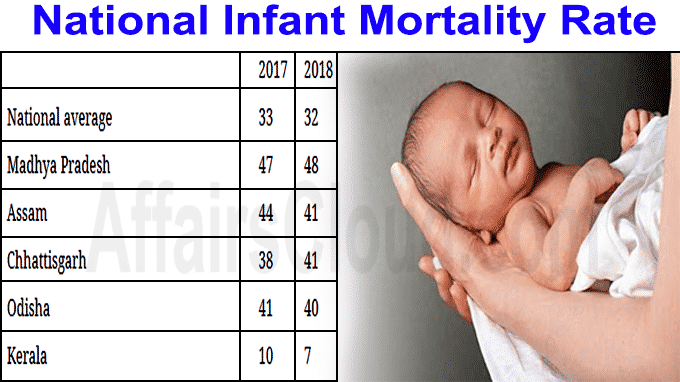
- The rates are calculated per one thousand of the population.
- The current sample is based on the 2011 Census frame. The SRS sample is replaced every ten years based on the latest census frame.
Let us go through the SRS Bulletin starting with IMR:
Infant Mortality Rate (IMR): It is the number of deaths per 1,000 live births of children under one year of age.
- National Average: India’s infant mortality rate (IMR) has improved very marginally from 33 per 1,000 live births in 2017 to 32 in 2018. In 2009-2018 it has declined from 50 to 32. The present figure of 32 is about one-fourth as compared to 1971 (129).
- Urban & Rural Areas: The decline in rural areas in 2009-2018 is 55 to 36, and for urban areas it is from 34 to 23. With regard to percentage, there is a decline of about 35% in rural areas and about 32% in urban areas.
Important points with respect to IMR are collaborated in the following table
| Category | State/UT |
|---|---|
| Maximum IMR | Madhya Pradesh (MP)- 48 |
| Minimum IMR | Nagaland (4) |
| State with largest decline of IMR | Mizoram (from 15 to 5) |
| Best performer among larger states | Kerala (7) |
| Best performer among smaller states | Nagaland (4) |
| Best Performer among UTs | Andaman and Nicobar islands (9) |
| Maximum urban rural differential | Madhya Pradesh with the rural IMR at 51while the urban IMR is at 32 |
Points to be noted:
–Kerala is one of the state with an IMR in single digits at 7. It is also the only state which has now achieved the United Nations’ (UN’s) Sustainable Development Goals (SDG) target for IMR reduction, set at eight for the year 2020.
–Despite the decline in IMR over the last decades, one in every 31 infants die within first year of their life at the National level (irrespective of rural urban); one in every 28 infants in rural areas and one in every 43 infants in urban areas still die within one year of life.
–In the last 10 years, Child and infant mortality continues to be a massive problem in India despite improvements over the years. An estimated 8,82,000 children under the age of 5 died in 2018 in India.
Death Rate: Mortality is one of the basic components of population change. Death rate is the ratio of deaths to the population of a particular area or during a particular period of time
- National average: The death rate of India has witnessed a significant decline over the last four decades from 14.9 in 1971 to 6.2 in 2018. At all India level it has declined from 7.3 to 6.2 in 2009-2018.
- Urban & Rural Areas: The corresponding decline in rural areas is 7.8 to 6.7, and for urban areas it is from 5.8 to 5.1. The rate of decline in these years has been higher in rural areas (around 14.5%) than in the urban areas (12.7%).
| Category | State/UT |
|---|---|
| Highest Death Rate | Chhattisgarh (8.0) |
| Lowest Death Rate | Delhi (3.3) |
Birth Rate: Birth rate is a crude measure of fertility of a population and a crucial determinant of population growth. It gives the number of live births per thousand population in a given region and year.
- National average: There has been about an 11% decline in birth rate in the last decade, from 22.5 in 2009 to 20.0 in 2018. It has declined drastically over the last four decades from 36.9 in 1971 to 20.0 in 2018.
- Urban & Rural Areas: The decline in 2009-2018 in rural areas is 24.1 to 21.6, and in urban areas, it is 18.3 to 16.7.
- Urban rural differential: The rural-urban differential has also narrowed. In 2018, the birth rate for India varies from 16.7 in urban regions to 21.6 in rural regions. However, the birth rate has continued to be higher in rural areas compared to urban areas in the last four decades.
| Category | State/UT |
|---|---|
| Highest Birth Rate | Bihar (26.2) |
| Lowest Birth Rate | Andaman & Nicobar Islands (11.2) |
About SRS:
Initiated on a pilot basis by the Registrar General of India in a few states in 1964-65, it became fully operational during 1969-70. It is a demographic survey for providing reliable annual estimates of infant mortality rate, birth rate, death rate and other fertility and mortality indicators at the national and sub-national levels.
About Office of the Registrar General & Census Commissioner, India (ORGI)
Works under– Ministry of Home Affairs
Registrar General & Census Commissioner– Dr. Vivek Joshi